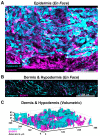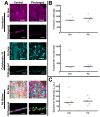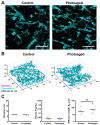Development of a Vascularized Human Skin Equivalent with Hypodermis for Photoaging Studies
- PMID: 36551256
- PMCID: PMC9775308
- DOI: 10.3390/biom12121828
Development of a Vascularized Human Skin Equivalent with Hypodermis for Photoaging Studies
Abstract
Photoaging is an important extrinsic aging factor leading to altered skin morphology and reduced function. Prior work has revealed a connection between photoaging and loss of subcutaneous fat. Currently, primary models for studying this are in vivo (human samples or animal models) or in vitro models, including human skin equivalents (HSEs). In vivo models are limited by accessibility and cost, while HSEs typically do not include a subcutaneous adipose component. To address this, we developed an "adipose-vascular" HSE (AVHSE) culture method, which includes both hypodermal adipose and vascular cells. Furthermore, we tested AVHSE as a potential model for hypodermal adipose aging via exposure to 0.45 ± 0.15 mW/cm2 385 nm light (UVA). One week of 2 h daily UVA exposure had limited impact on epidermal and vascular components of the AVHSE, but significantly reduced adiposity by approximately 50%. Overall, we have developed a novel method for generating HSE that include vascular and adipose components and demonstrated potential as an aging model using photoaging as an example.
Keywords: HSE; aging; human skin equivalent; photoaging; scaffold; self-assembly; tissue engineering.
Conflict of interest statement
The authors declare no conflict of interest. The funders had no role in the design of the study; in the collection, analyses, or interpretation of data; in the writing of the manuscript; or in the decision to publish the results.
Figures






Similar articles
-
Trans-cinnamic acid attenuates UVA-induced photoaging through inhibition of AP-1 activation and induction of Nrf2-mediated antioxidant genes in human skin fibroblasts.J Dermatol Sci. 2018 May;90(2):123-134. doi: 10.1016/j.jdermsci.2018.01.004. Epub 2018 Feb 1. J Dermatol Sci. 2018. PMID: 29395579
-
Circ_0011129 Encapsulated by the Small Extracellular Vesicles Derived from Human Stem Cells Ameliorate Skin Photoaging.Int J Mol Sci. 2022 Dec 6;23(23):15390. doi: 10.3390/ijms232315390. Int J Mol Sci. 2022. PMID: 36499715 Free PMC article.
-
Metformin Attenuates UVA-Induced Skin Photoaging by Suppressing Mitophagy and the PI3K/AKT/mTOR Pathway.Int J Mol Sci. 2022 Jun 23;23(13):6960. doi: 10.3390/ijms23136960. Int J Mol Sci. 2022. PMID: 35805987 Free PMC article.
-
Application of adipose-derived stem cells in photoaging: basic science and literature review.Stem Cell Res Ther. 2020 Nov 23;11(1):491. doi: 10.1186/s13287-020-01994-z. Stem Cell Res Ther. 2020. PMID: 33225962 Free PMC article. Review.
-
Therapeutic potential of adipose tissue derivatives in skin photoaging.Regen Med. 2023 Nov;18(11):869-883. doi: 10.2217/rme-2023-0098. Epub 2023 Sep 25. Regen Med. 2023. PMID: 37743749 Review.
Cited by
-
Tranexamic Acid Ameliorates Skin Hyperpigmentation by Downregulating Endothelin-1 Expression in Dermal Microvascular Endothelial Cells.Ann Dermatol. 2024 Jun;36(3):151-162. doi: 10.5021/ad.23.108. Ann Dermatol. 2024. PMID: 38816976 Free PMC article.
-
Unveiling the impact of hypodermis on gene expression for advancing bioprinted full-thickness 3D skin models.Commun Biol. 2024 Nov 11;7(1):1437. doi: 10.1038/s42003-024-07106-4. Commun Biol. 2024. PMID: 39528562 Free PMC article.
-
Ideal Living Skin Equivalents, From Old Technologies and Models to Advanced Ones: The Prospects for an Integrated Approach.Biomed Res Int. 2024 Aug 16;2024:9947692. doi: 10.1155/2024/9947692. eCollection 2024. Biomed Res Int. 2024. PMID: 39184355 Free PMC article. Review.
-
Organoids/organs-on-chips towards biomimetic human artificial skin.Burns Trauma. 2025 May 3;13:tkaf029. doi: 10.1093/burnst/tkaf029. eCollection 2025. Burns Trauma. 2025. PMID: 40740685 Free PMC article. Review.
-
Replicating Dynamic Immune Responses at Single-Cell Resolution within a Microfluidic Human Skin Equivalent.Adv Sci (Weinh). 2025 Mar;12(10):e2415717. doi: 10.1002/advs.202415717. Epub 2025 Jan 21. Adv Sci (Weinh). 2025. PMID: 39836544 Free PMC article.
References
-
- Farage M.A., Miller K.W., Zouboulis C.C., Piérard G.E., Maibach H.I. Gender differences in skin aging and the changing profile of the sex hormones with age. J. Steroids Horm. Sci. 2012;3:109. doi: 10.4172/2157-7536.1000109. - DOI
Publication types
MeSH terms
Grants and funding
LinkOut - more resources
Full Text Sources
Other Literature Sources
Medical

